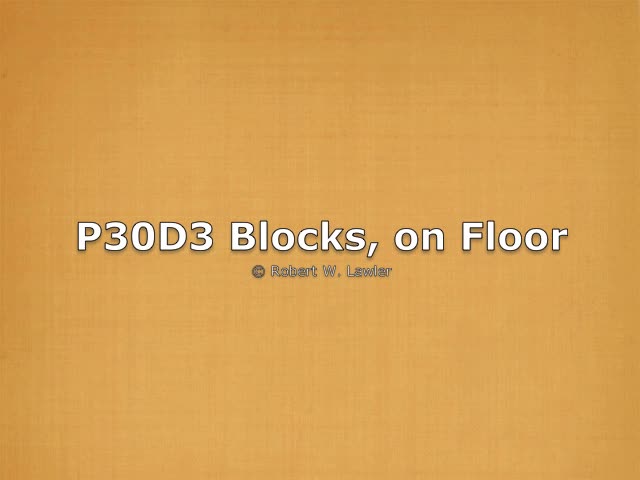
P030D3 Clip Notes
| Notes:n:nn | by Analyst, 9/16/2025 |
| Setting,Props | Cedar Hall, Family Room: about 15 inch and a quarter Blocks |
| Actors,Aims | Peggy, with Mom helping; Bob on camera |
| Episode A: [00:00:03] | Mom: Peg, give me this. You can have all those. [spreads numerous (~15) small (~1.25″) blocks] |
| Episode B: [00:00:10] | Peggy: [begins sampling from the large number of blocks] |
| Episode C: [00:02:13] | Bob: She does seem to be looking at an awful lot of different blocks. Is she testing the edges by trying to chew on them to make sure that the things that look the same feel the same in the mouth? |
| Episode D: [00:02:25] | Peggy: [throws (puts down energetically) a block after sampling it] Bob: Oh, lost that one, huh, Peg? |
| Episode | |
| Summary by AI |
Participants: Mom, Peggy (infant/toddler), and Bob (observer/commentator). Mom spreads approximately 15 small blocks (~1.25 inches) and offers them to Peggy. Peggy begins actively sampling the blocks from the scattered set. The sampling appears methodical as Peggy examines many different blocks. Bob notes Peggy is looking at “an awful lot of different blocks.” Bob hypothesizes Peggy is testing edges by mouthing/chewing to compare feel with appearance. Peggy energetically discards one block after sampling it. Bob comments humorously, “Oh, lost that one, huh, Peg?” Overall, the scene captures exploratory, oral-sensory investigation of small blocks by Peggy. |
| Narrative by AI |
In a brief home video, a caregiver places a collection of small wooden blocks in front of a child named Peggy. The blocks, roughly an inch and a quarter in size, are spread out in a loose cluster, creating a small field of options. Peggy begins to engage with them immediately, moving from block to block in a focused yet exploratory manner, selecting and handling each one in turn. As Peggy explores, an observer—identified as Bob—notes that she appears to examine many different blocks rather than focusing on just one or two. This kind of broad sampling is common in early play: children often test variety before preference, using touch, sight, and sometimes taste to compare objects that seem similar at a glance. The range of options becomes part of the experience, inviting repeated, brief contact with each piece. Bob wonders aloud whether Peggy is testing the edges with her mouth to confirm that blocks which look alike also feel alike. For infants and toddlers, the mouth is a key sensory organ, and “mouthing” is a typical way to gather information about texture, temperature, weight, and shape. When objects are visually similar, oral exploration can help resolve subtle differences and build multisensory understanding. At one point, after sampling a block, Peggy decisively sets it down with energy—what might read as a throw to an adult eye but is, in context, a clear, purposeful release. This gesture suggests a moment of evaluation: a quick decision that a particular block is less interesting, or perhaps simply “done” for now. Bob responds lightly, “Oh, lost that one, huh, Peg?” highlighting how caregivers often narrate a child’s actions to connect, scaffold language, and frame the activity. Taken together, the scene illustrates the quiet richness of early exploration. With minimal prompting, Peggy engages in self-directed inquiry, comparing like with like and using multiple senses to gather data. The adults observe and comment without interrupting, allowing curiosity to drive the session. It’s a snapshot of everyday development: small objects, short moments, and a steady stream of choices that build the foundations of perception and understanding. |
| Link Index | Panel P030, Language Development, Object Exploration, Social Interactions |
| Themes, Interplay |
